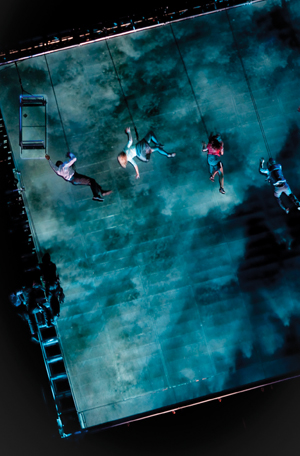A fine balancing act
Outdoor arts have risen in profile over the past ten years. Bill Gee examines the position of the sector in relation to the current economic climate and the countdown to 2012

In June I saw Wired Aerial Theatre’s ‘As the World Tipped’ at the Greenwich and Docklands International Festival. Written and directed by Nigel Jamieson, the show explicitly examined the failure of the 2009 Copenhagen Climate Change talks. As the audience watch the talks fail, and spectators are presented with the extraordinary image of the bureaucrats and their stacks of unsigned agreements literally sliding away from them as the stage tips from the horizontal to the vertical. Hoisted into the sky under a crane, this now giant vertical screen is a surface for the skilled aerial performers to interact with a projected visual world depicting impacts of climate change, concluding with a clear call to change. It is a remarkable piece of UK-made large-scale outdoor performance that has been presented successfully up and down the country.
Also during the summer I have had many conversations with colleagues from other festivals and local authorities, about significant cuts to outdoors projects, particularly in 2013 after London 2012 has come and gone. Like the central image in ‘As the World Tipped’ I find my thoughts at a tipping point as to how well the recent growth
and development in outdoor arts will survive the current economic situation and specifically the cuts to funding in local government, which has consistently been one of the key backers of outdoor arts.
The decade has seen both Arts Council England (ACE) and Creative Scotland develop their engagement with the outdoor arts. ACE’s 2008 ‘New Landscapes’ outdoor arts development plan articulated the increasing importance of the sector, key priorities and needs for growth. This coincided with the clear adoption of the mission ‘Great Art for Everyone’. Outdoor arts events consistently deliver great art for large audiences, many of who don’t regularly engage with other professional arts. Main points of access for these new audiences have been that work is presented in spaces that have a strong sense of public ownership such as streets, squares and parks, and that it is often presented for free. ACE’s new investment strategy and the creation of National Portfolio Organisations has stabilised funding for a number of relatively new festivals such as IF Milton Keynes, Lakes Alive and Inside Out Dorset, but has also created a number of casualties. Inevitably, despite a rise in profile, the majority of ACE investment to the sector will still be through project funds.
A significant beneficiary of project funds has been Without Walls – a consortium of eight outdoor arts festival across England that over the past five years has invested over £2m in the commissioning and presentation of new outdoor works from small to large scale. A balance exists between festivals that are outdoor-focused, such as Stockton International Riverside Festival and Winchester Hat Fair, with others such as Brighton Festival and Norfolk and Norwich Festival that present work both indoors and outdoors. Their commissioning decisions have supported a real diversity of artists, practices and forms of presentation. Companies regularly working outdoors, such as the Whalley Range All Stars, the World Famous and indeed Wired Aerial, have been supported to make ambitious works; and companies that traditionally work indoors have successfully embraced the outdoors, including Graeae Theatre, Srishti and Stopgap. Without Walls estimates that more than 1.5 million people have enjoyed the performances presented as part of the programme and that these have been a very important part of developing the diversity and quality of the outdoor arts in recent years.
However, a number of established outdoor festivals including the Trafalgar Square festival, Big in Falkirk, The Bristol Do and Paradise Gardens have either, disappeared, amalgamated with other events or significantly reduced in scale. Many of these have local authorities as the direct project commissioner. Despite evidence that oudoor arts contribute to regeneration agendas, help develop a sense of community and provide significant economic impacts, some local authorities facing significant financial challenges have made cuts to this non-statutory area of provision. Many local authority arts and event organisers are working hard on their predominately outdoor plans for London 2012 Cultural Olympiad activity and there is a sense that this will protect budgets and staff at least for the coming year when a host of projects will be taking place: the GLA London Outdoor Arts Festival, Legacy Trust-funded community celebrations, London 2012 Festival commissions, and local events that are being put together along the Olympic Torch Relay route. These mean that millions of people will enjoy outdoor arts.
Whilst anticipating a positive legacy from 2012, the characteristics of the outdoor arts sector – great imagination, responsiveness, fleet of foot nature and lack of permanent buildings – could also be some of the things that make it vulnerable in coming years. It will need ongoing vision, commitment and investment to ensure audiences will be experiencing more projects of the quality of ‘As the World Tipped’ up and down the country.
Join the Discussion
You must be logged in to post a comment.